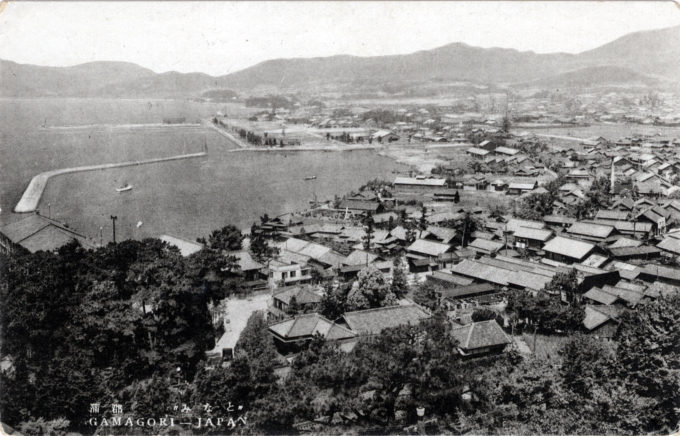“There is one [hotel] which every foreign visitor tries to stay at. This is the Gamagori. It is the perfect blend of the Swiss chalet and the rustic American or Canadian log cabin. It is neither too large to give the impression of being a glorified barracks, nor too small to make it impossible to choose your friends there.
“I said that it has something of the Swiss chalet about it. This is true to a degree in many of the Japanese resort hotels, since Japan resembles Switzerland so much, and in the matter of first-rate hotel service the Japanese are rivals of the experienced Swiss.”
– “Japan’s Hotels and Hospitality”, Travel in Japan, Vol. 4. No. 4, 1938

Gamagori Hotel, Gamagori, Aichi Prefecture, c. 1940. The hotel opened in 1934 on the seafront of the harbor town of Gamagori, in Aichi Prefecture.
“The Kamagori (Gamagori) Hotel, newly constructed on a hill overlooking the islet-studded Ise Bay, is up-to-date in every respect, and offers superior cuisine and excellent accommodation for visitors.
“Externally the hotel somewhat resembles an old feudal castle, blending perfectly with the Japanese landscape gardens in which it stands.
“The view from the Hotel is singularly impressive. At the foot of the hill stretch golden sands, where a long bridge leads to a small rockbound island, densely clothed with gnarled pine trees and surmounted by a picturesque temple. Seawards one looks out over the vast waters of Ise Bay whilst on the landward side lie fertile plains bounded by verdant hills.”
– Japan Handbook: Information for Visitors, Cook’s and Wagon-Lit World Travel Service, 1935
“The first leg of the journey saw them board an early morning express train [from Tokyo] to Gamagori on the Tokaido Line where, some three hours later, they checked-in at the Gamagori Hotel.
“… [T]his distinguished and pretty hotel stood three floors high and was roofed with sparkling green tiles. Their front-facing rooms overlooked the calm Mikawa Bay with superb views of Takeshima Island, the Yaotomi Shrine and other small islands. Members of the Japanese royal family were among the guests who had stayed over the years. Rooms cost ¥900-¥7,000 without a meal, and the hotel boasted a golf course and a table tennis room.
“By now Hughes and Saito had learned Fleming’s working methods: the day was usually given over to travel and sight-seeing. If he had a thought or wanted to record something he would write it down in a small notepad. Back at the hotel in the evening, he would spend a couple of hours before dinner writing up his notes in a loose-leaf soft covered notebook. The Japanese for ‘top secret’, gokuhi, was one word he wrote down.
“Next morning they ate a Western-style buffet, though not before Hughes puffed his way through one of his cheap cigars, his way of starting evening morning … Packed and with the bill settled, they took a taxi from Gamagori to Irago, a small port further round the Mikawa Bay on the Atsumi Peninsula. From here a hydrofoil call the Pearl Queen ran a swift trip to Mikomoto’s pearl fisheries on a small island off Toba.
– The Story of “You Only Live Twice”: Fleming, Bond and Connery in Japan, by Graham Thomas, 2018
“Gamagori is located in the middle of Japan, on the island of Honshu. It is believed that people settled here approximately 8,500 years ago. The area has many Shinto shrines and Buddhist temples.
“A seaside resort, Gamagori lies between the Atsumi and Chita Peninsulas. The climate is mild. It rains less than 10% of the year. Even if it snows, the snow rarely settles.”
– From Japan with Love, by Mary A. (Kiddie) Ruggieri, 2007




